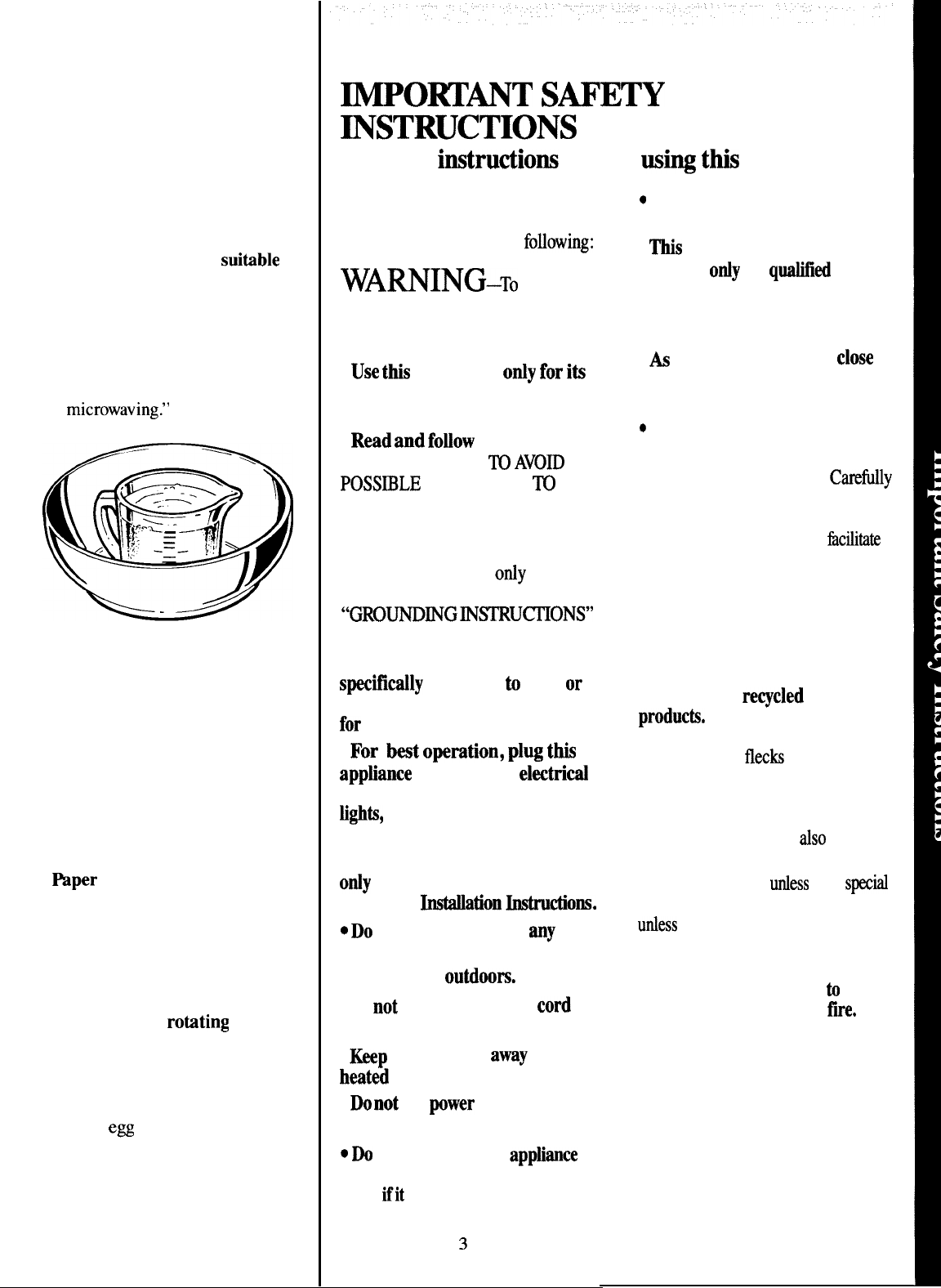
Microwaving Tips
●
Make sure all cookware used in
your microwave oven is
suitible
for microwaving.
Most glass
casseroles, cooking dishes,
measuring cups, custard cups,
pottery or china dinnerware which
does not have metallic trim or glaze
with a metallic sheen can be used.
Some cookware is labeled “suitable
for
microwaving:’
If you are not sure if a dish is
microwave-safe, use this test:
Place in the oven both the dish you
are testing and a glass measuring
cup filled with one cup water—set
the measuring cup either in or next
to the dish. Microwave 1 minute at
high. If the dish heats, it should not
be used for microwaving. If the dish
remains cool and only the water in
the cup heats, then the dish is
microwave-safe.
●
Rper
towels, wax paper and
plastic wrap
can be used to cover
dishes in order to retain moisture
and prevent spattering. Be sure to
vent plastic wrap so steam can
escape.
. Some microwaved foods
require stirring,
rotiting
or
rearranging.
Check the cookbook.
● Steam builds up pressure in
foods which are tightly covered
by a skin or membrane. Pierce
potatoes,
egg
yolks and chicken
livers to prevent bursting.
~O~~T
SNETY
~STRUCTIONS
Read all
instrudions
before
usiq
tMs
appliance.
When using electrical appliances,
basic safety precautions should be
followed, including the
fo~owing:
WAMING–TO
reduce
the risk of burns, electric shock,
fire, injury to persons or exposure
to excessive microwave energy:
.
Use
this
appliance
o~y
for
ib
intended use
as described in this
manual.
.
R-d
and
fo~ow
the
specific
“PRECAUTIONS
~
AVO~
POSS~LE
EXPOSURE
~
EXCESSIVE MICROWAVE
ENERGY” on page 2.
●
This appliance must be
grounded.
Connect
ordy
to
properly grounded outlet, See
“GROUND~GWSTRU~ONS”
on page 29.
. This microwave oven is
s~ificdly
designed
to
heat
or
cook food, and is not intended
for
laboratory or industrial use.
●
For
best
o~ration,
plug
tw
appMance
into its own
elwtricd
outlet, to prevent flickering of
hghts,
blowing of fuse or
tripping of circuit breaker.
●
Install or locate this appliance
otiy in accordance with the
provided
=ation
_ctions.
o
Do
not cover or block
any
openings on the appliance.
●
Do not use
outdoo~.
●
D
O
not
immerse power
coti
or plug in water.
●
~p
power cord
away
from
h~ted
surfaces.
●
DO
not
let
power
cord
hang
over edge of table or counter.
*
Do
not operate this
apptiance
if
it has a damaged power cord or
plug,
ifit
is not working properly,
or if it has been damaged or
dropped.
~
c
See door surface cleaning
instructions on page 28.
.
ws
appliance should be
serviced
o~y by
qua~led
service
personnel.
Contact nearest
authorized service facility for
examination, repair or adjustment.
.
&
with
any
appliance,
close
supervision is necessary when
used by children.
o
To reduce the risk of fire in
the oven cavity:
–Donot overcook food.
CmWy
attend appliance if paper, plastic,
or other combustible materials are
placed inside the oven to
fictiitate
cooking.
–Remove wire twist-ties
from
paper or plastic bags before
placing bags in oven.
—Do not use your microwave
oven to dry newspapers.
–Do not use
reqcled
paper
produc~.
Recycled paper towels,
napkins and wax paper can
contain metal
flecks
which may
cause arcing or ignite. Paper
products containing nylon or
nylon filaments should be
avoided, as they may
dso ignite.
–Do not pop popcorn in your
microwave oven
mess in
a
specti
microwave popcorn accessory or
udess
you use popcorn labeled for
use in microwave ovens.
–Do
not operate the oven while
empty to avoid damage
to
the
oven and the danger of
fm.
If
by accident the oven should run
empty a minute or two, no harm
is done. However, try to avoid
operating the oven empty at all
times–it saves energy and
prolongs the life of the oven.
–Do not overcook potatoes.
They
could dehydrate and catch
fire, causing damage to your oven.


















